Abstract
1. In eight normal volunteers, the adductor pollicis (AP) was fatigued using intermittent trains of programmed, supramaximal stimulation at 1, 10, 20, 50, 100 and 1 Hz. Activity protocols were performed both with and without circulatory occlusion, both without and during propranolol 80 mg thrice daily in order to investigate the effects of beta-adrenoceptor blockade on 'peripheral' fatigue mechanisms. 2. The degree of beta-adrenoceptor blockade was assessed by the reduction of exercise tachycardia during cycle ergometry, e.g. pulse rates at 210 watts were reduced from 190 +/- 15 to 127 +/- 5 beats min-1 (mean +/- 1 s.d.) indicating that beta-adrenoceptor blockade was substantial and highly significant (P less than 0.001). 3. Before, during and following fatiguing activity with circulatory occlusion force declines were identical during and without beta-adrenoceptor blockade. During and following activity without occlusion, there were slight declines in force which were questionably significantly different at 20 Hz (P less than 0.05). 4. The compound muscle action potential (CMAP) amplitude, measured from the skin surface over the muscle, was unaltered by beta-adrenoceptor blockade before, during or after activity whether with or without circulatory occlusion. 5. The maximal relaxation rate (MRR) was not significantly reduced in previously unfatigued muscle during beta-adrenoceptor blockade. During activity, both with and without circulatory occlusion, there was no evidence that MRR was reduced significantly more during beta-adrenoceptor blockade. 6. The absence of a convincing effect of beta-adrenoceptor blockade on peripheral fatigue mechanisms may indicate that central mechanisms are involved or that impairments of peripheral force production, of a specific nature or as a result of exacerbation of limitations of circulatory oxygen transport, though small are detected during voluntary exercise and give rise to increases in motor unit recruitment and/or firing rates, and hence increased perception of fatigue.
Full text
PDF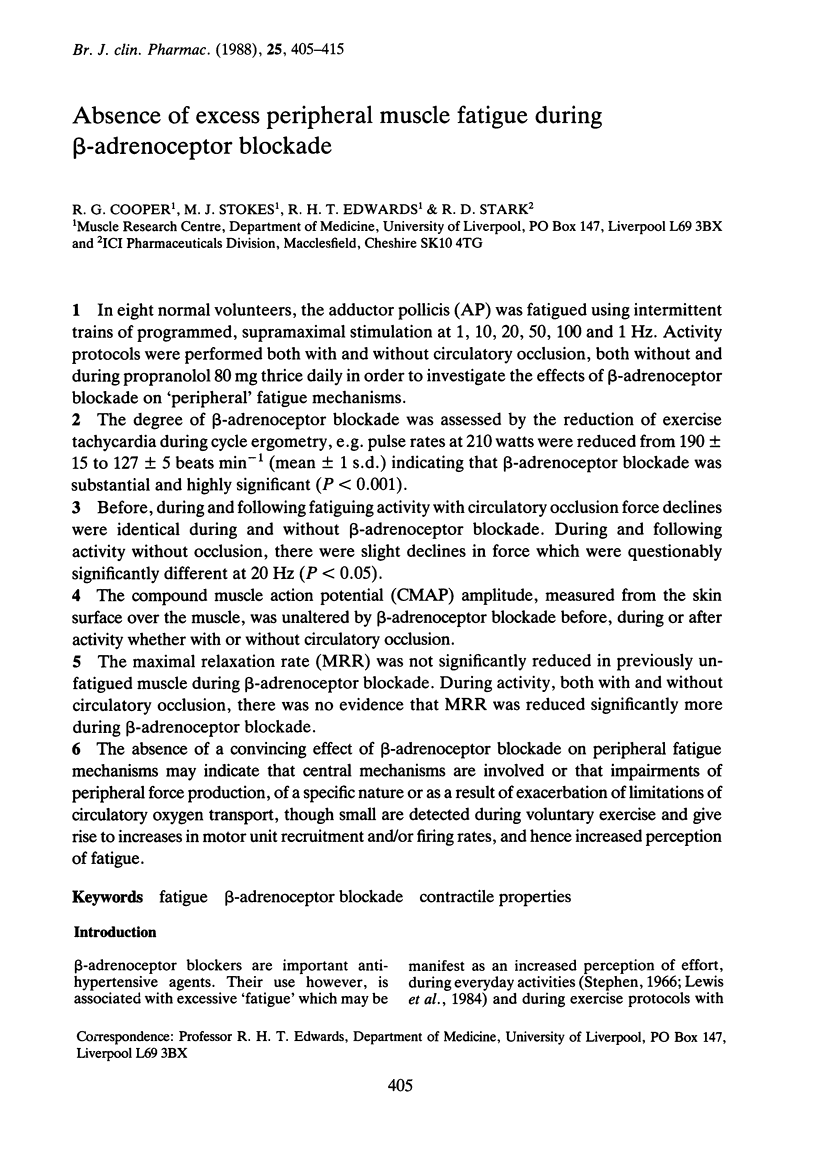
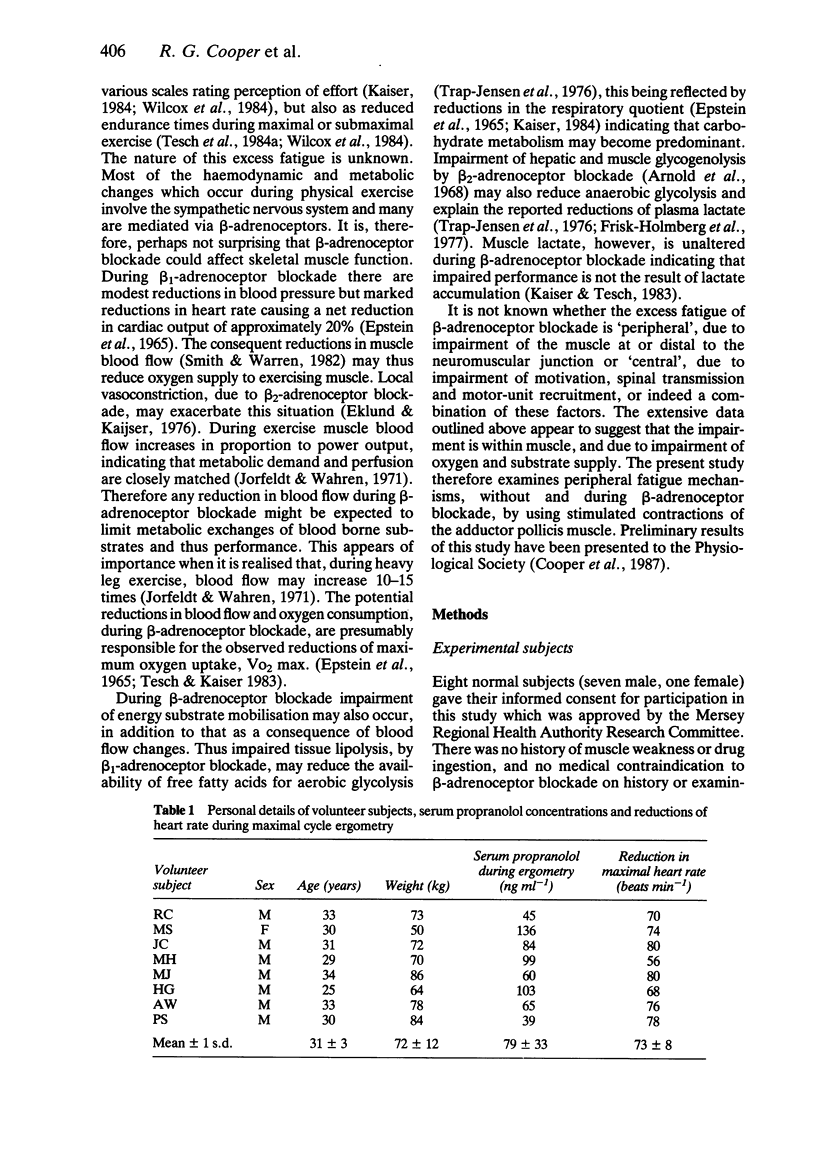
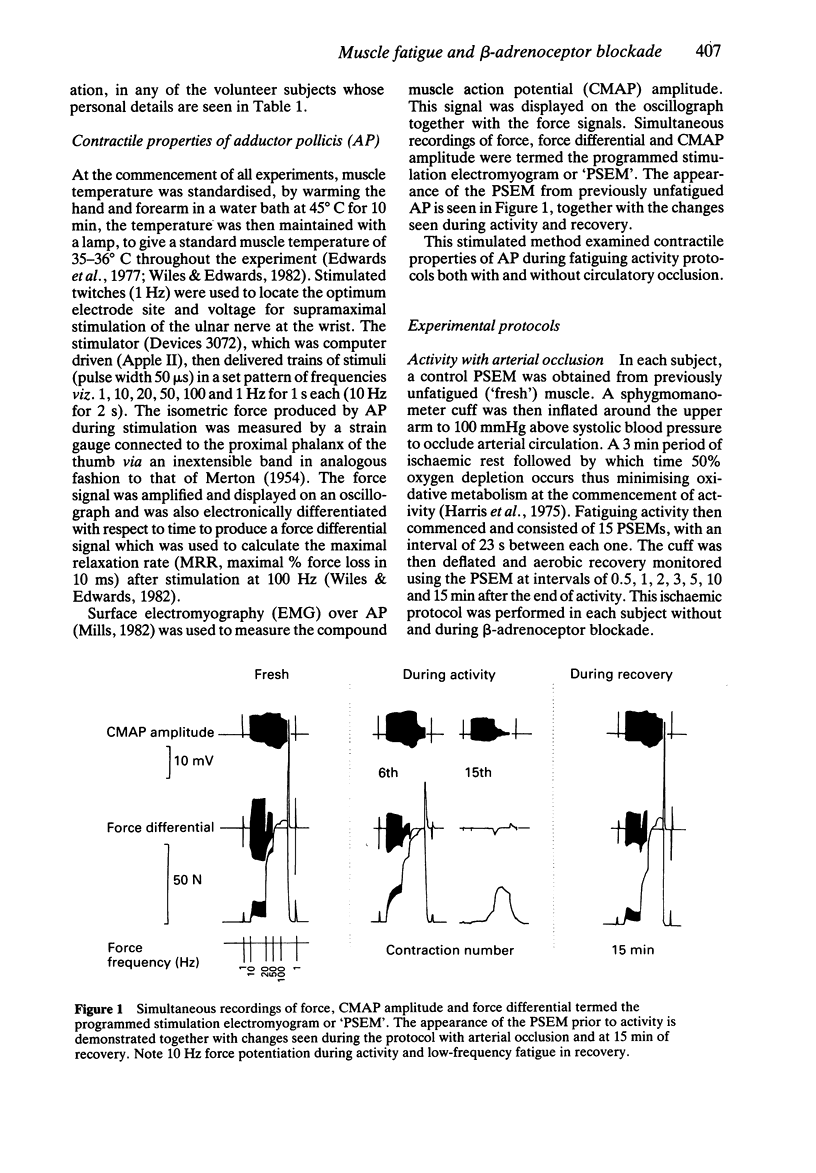
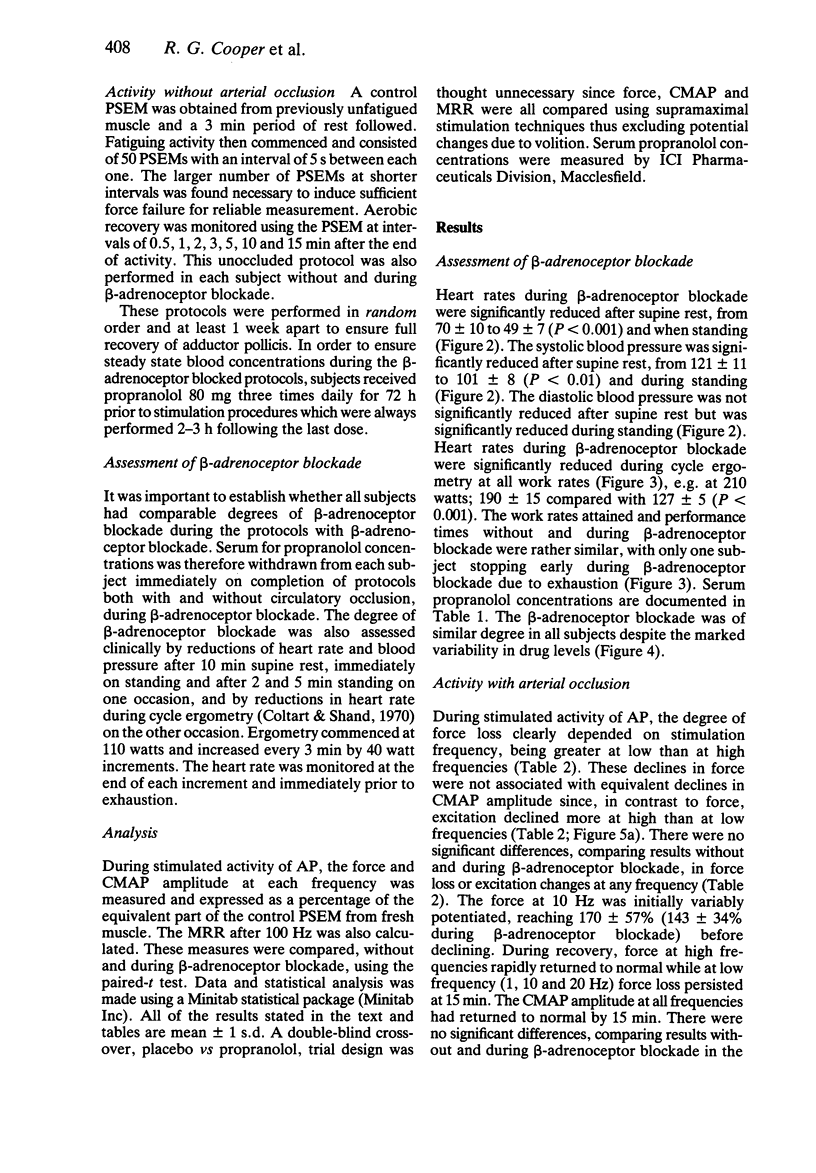
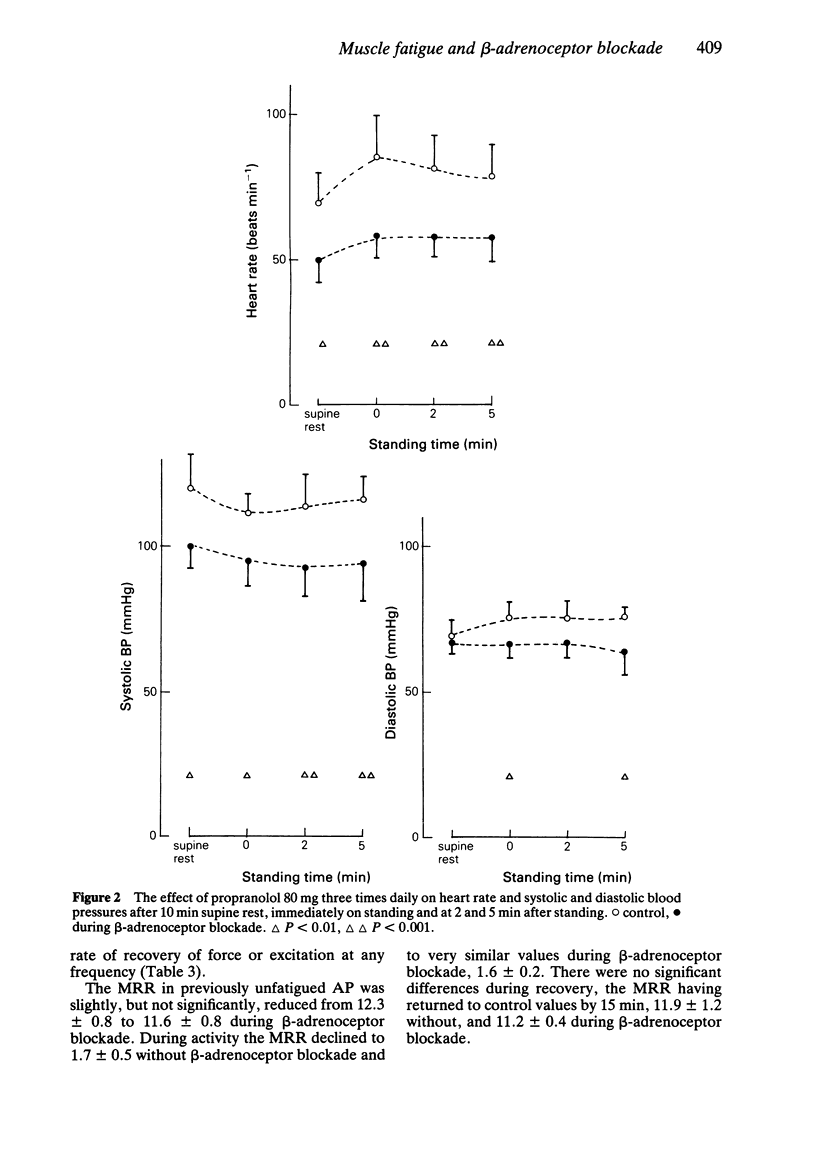
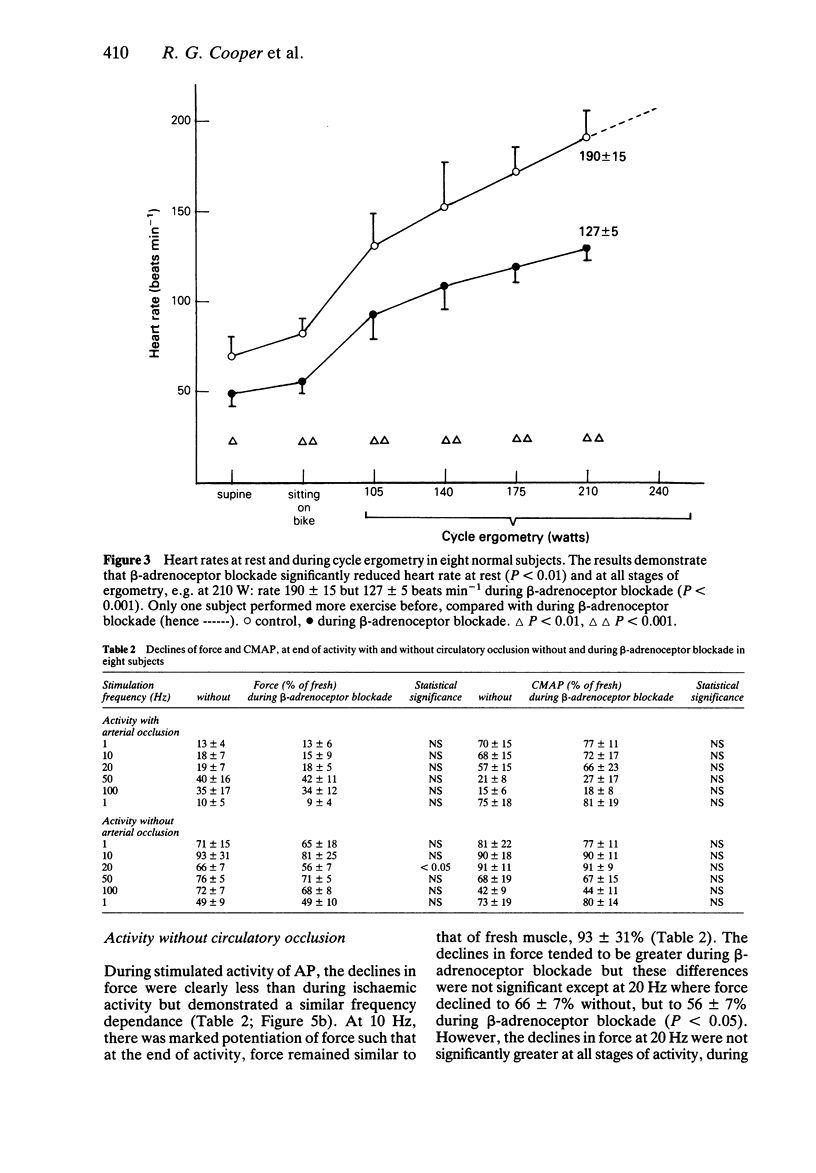
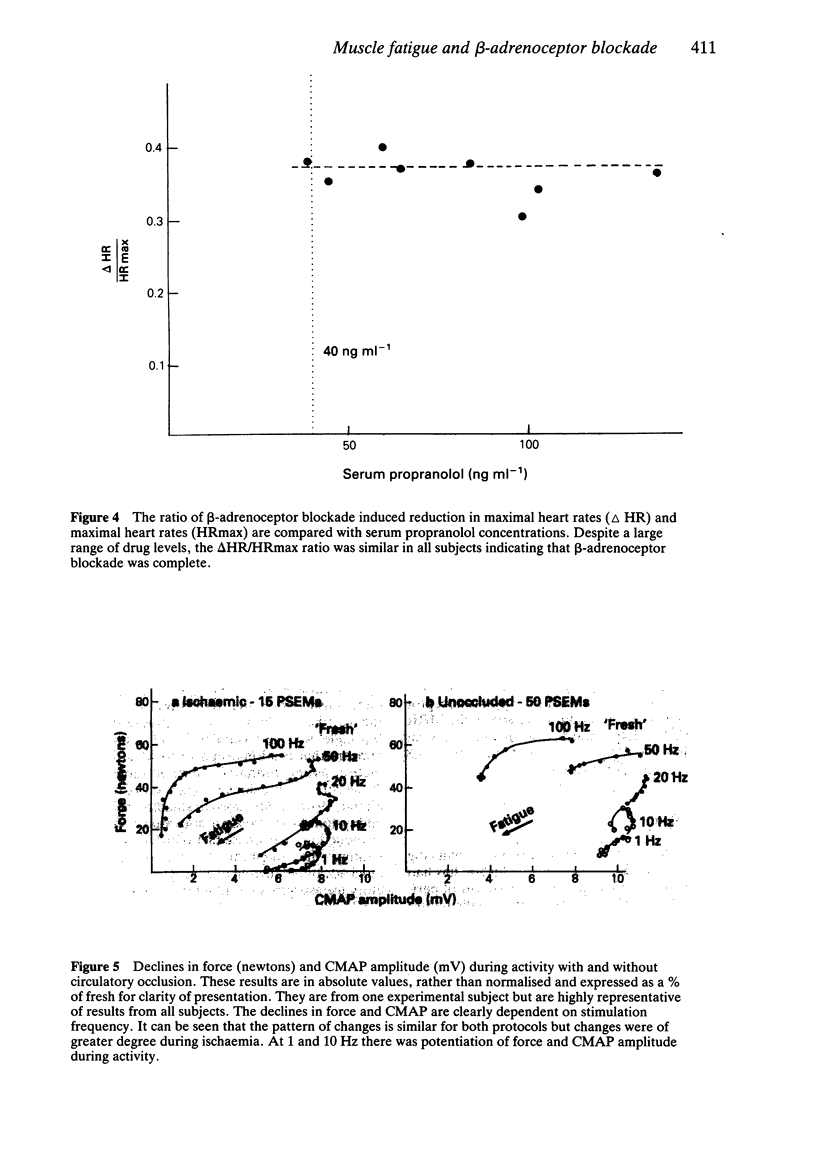
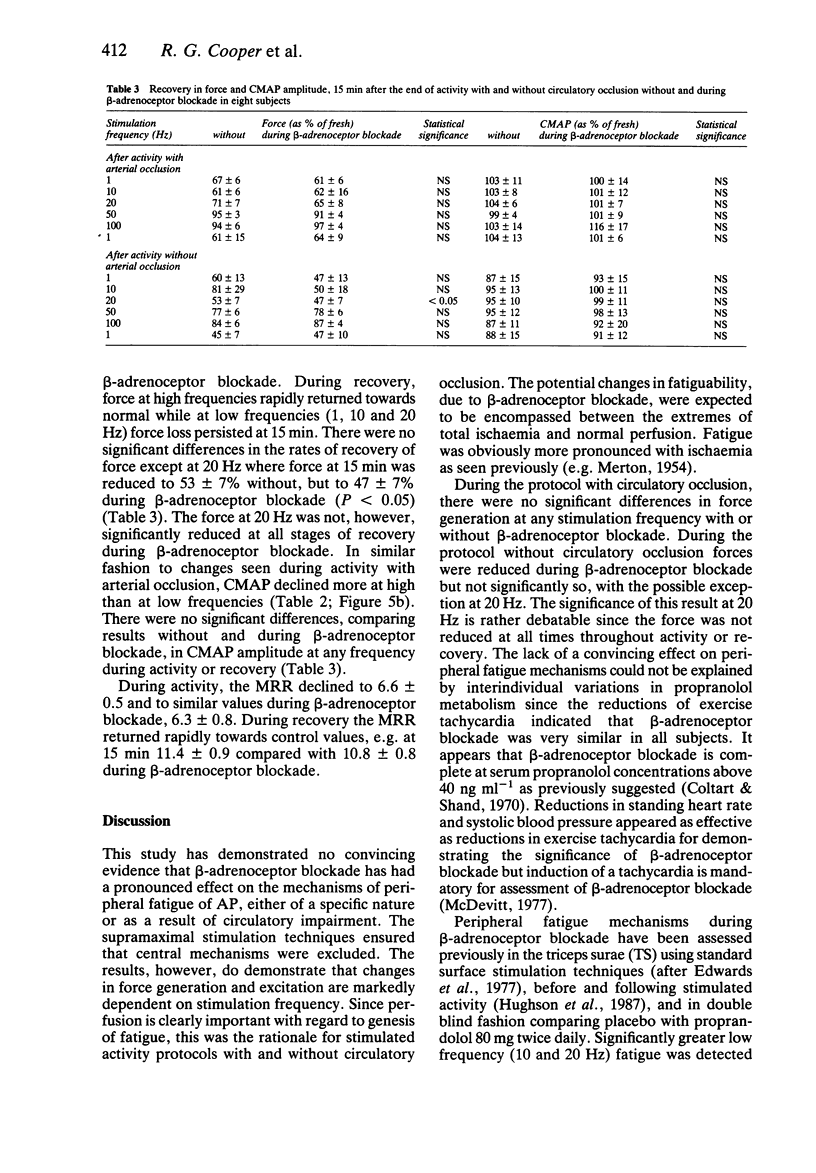
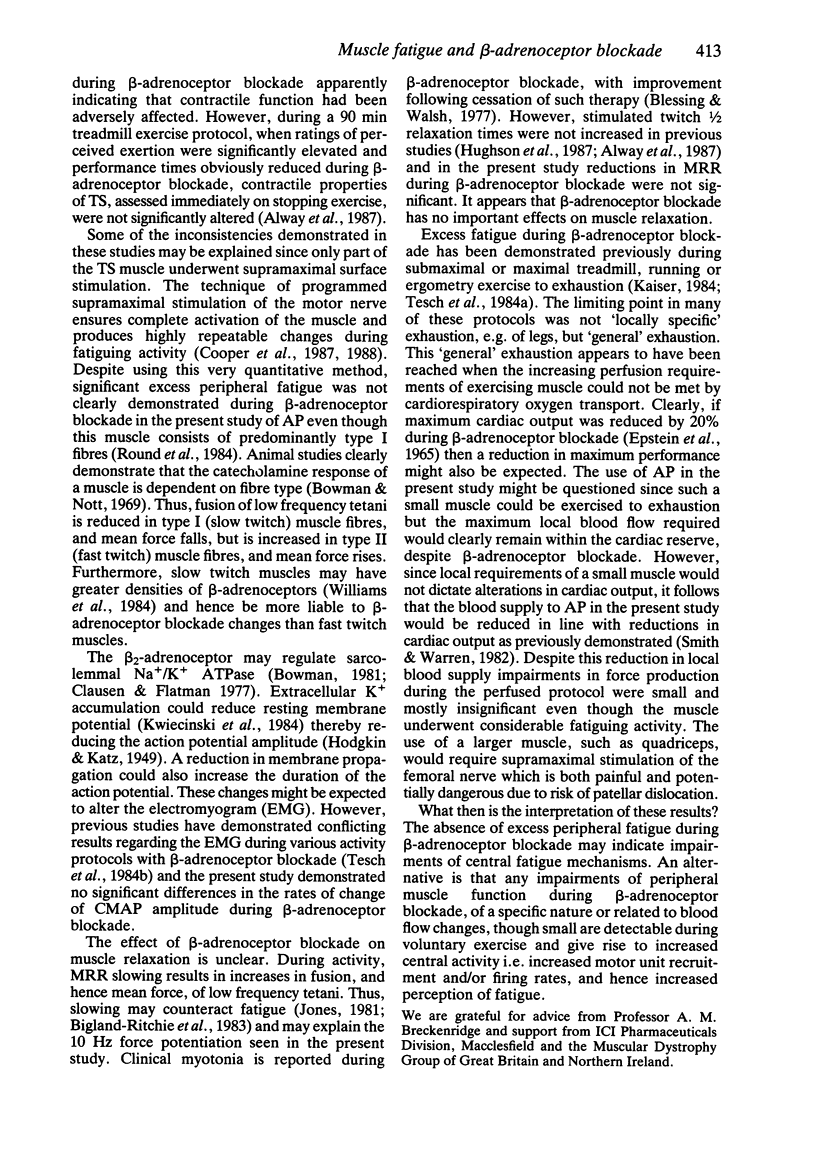
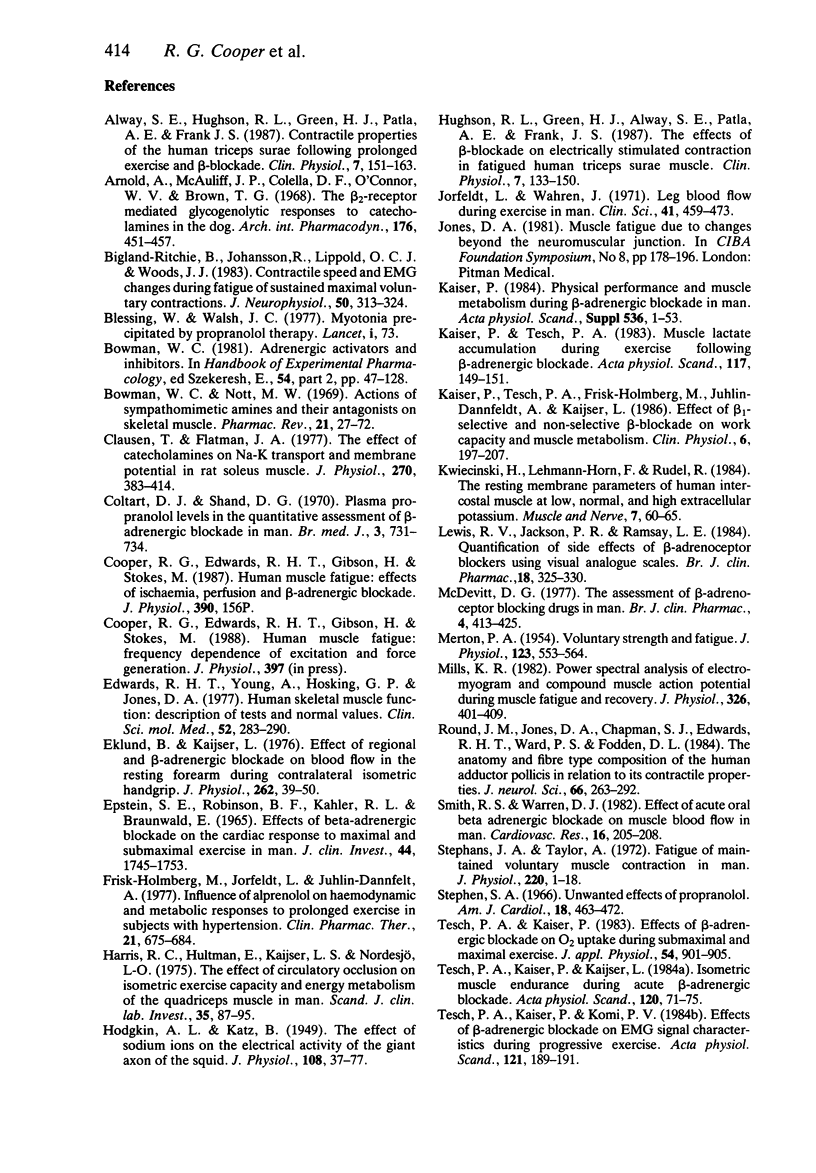

Selected References
These references are in PubMed. This may not be the complete list of references from this article.
- Alway S. E., Hughson R. L., Green H. J., Patla A. E., Frank J. S. Contractile properties of the human triceps surae following prolonged exercise and beta-blockade. Clin Physiol. 1987 Apr;7(2):151–163. doi: 10.1111/j.1475-097x.1987.tb00156.x. [DOI] [PubMed] [Google Scholar]
- Arnold A., McAuliff J. P., Colella D. F., O'Connor W. V., Brown T. G., Jr The beta-2 receptor mediated glycogenolytic responses to catecholamines in the dog. Arch Int Pharmacodyn Ther. 1968 Dec;176(2):451–457. [PubMed] [Google Scholar]
- Bigland-Ritchie B., Johansson R., Lippold O. C., Woods J. J. Contractile speed and EMG changes during fatigue of sustained maximal voluntary contractions. J Neurophysiol. 1983 Jul;50(1):313–324. doi: 10.1152/jn.1983.50.1.313. [DOI] [PubMed] [Google Scholar]
- Blessing W., Walsh J. C. Myotonia precipitated by propranolol therapy. Lancet. 1977 Jan 8;1(8002):73–74. doi: 10.1016/s0140-6736(77)91083-2. [DOI] [PubMed] [Google Scholar]
- Bowman W. C., Nott M. W. Actions of sympathomimetic amines and their antagonists on skeletal muscle. Pharmacol Rev. 1969 Mar;21(1):27–72. [PubMed] [Google Scholar]
- Clausen T., Flatman J. A. The effect of catecholamines on Na-K transport and membrane potential in rat soleus muscle. J Physiol. 1977 Sep;270(2):383–414. doi: 10.1113/jphysiol.1977.sp011958. [DOI] [PMC free article] [PubMed] [Google Scholar]
- Coltart D. J., Shand D. G. Plasma propranolol levels in the quaniitative assessment of beta-adrenergic blockade in man. Br Med J. 1970 Sep 26;3(5725):731–734. doi: 10.1136/bmj.3.5725.731. [DOI] [PMC free article] [PubMed] [Google Scholar]
- Edwards R. H., Young A., Hosking G. P., Jones D. A. Human skeletal muscle function: description of tests and normal values. Clin Sci Mol Med. 1977 Mar;52(3):283–290. doi: 10.1042/cs0520283. [DOI] [PubMed] [Google Scholar]
- Eklund B., Kaijser L. Effect of regional alpha- and beta-adrenergic blockade on blood flow in the resting forearm during contralateral isometric handgrip. J Physiol. 1976 Oct;262(1):39–50. doi: 10.1113/jphysiol.1976.sp011584. [DOI] [PMC free article] [PubMed] [Google Scholar]
- Epstein S., Robinson B. F., Kahler R. L., Braunwald E. Effects of beta-adrenergic blockade on the cardiac response to maximal and submaximal exercise in man. J Clin Invest. 1965 Nov;44(11):1745–1753. doi: 10.1172/JCI105282. [DOI] [PMC free article] [PubMed] [Google Scholar]
- Frisk-Holmberg M., Jorfeldt L., Juhlin-Dannfeldt A. Influence of alprenolol on hemodynamic and metabolic responses to prolonged exercise in subjects with hypertension. Clin Pharmacol Ther. 1977 Jun;21(6):675–684. doi: 10.1002/cpt1977216675. [DOI] [PubMed] [Google Scholar]
- HODGKIN A. L., KATZ B. The effect of sodium ions on the electrical activity of giant axon of the squid. J Physiol. 1949 Mar 1;108(1):37–77. doi: 10.1113/jphysiol.1949.sp004310. [DOI] [PMC free article] [PubMed] [Google Scholar]
- Harris R. C., Hultman E., Kaijser L., Nordesjö L. O. The effect of circulatory occlusion on isometric exercise capacity and energy metabolism of the quadriceps muscle in man. Scand J Clin Lab Invest. 1975 Jan;35(1):87–95. [PubMed] [Google Scholar]
- Hughson R. L., Green H. J., Alway S. E., Patla A. E., Frank J. S. The effects of beta-blockade on electrically stimulated contraction in fatigued human triceps surae muscle. Clin Physiol. 1987 Apr;7(2):133–150. doi: 10.1111/j.1475-097x.1987.tb00155.x. [DOI] [PubMed] [Google Scholar]
- Jones D. A. Muscle fatigue due to changes beyond the neuromuscular junction. Ciba Found Symp. 1981;82:178–196. doi: 10.1002/9780470715420.ch11. [DOI] [PubMed] [Google Scholar]
- Jorfeldt L., Wahren J. Leg blood flow during exercise in man. Clin Sci. 1971 Nov;41(5):459–473. doi: 10.1042/cs0410459. [DOI] [PubMed] [Google Scholar]
- Kaiser P. Physical performance and muscle metabolism during beta-adrenergic blockade in man. Acta Physiol Scand Suppl. 1984;536:1–53. [PubMed] [Google Scholar]
- Kaiser P., Tesch P. A., Frisk-Holmberg M., Juhlin-Dannfelt A., Kaijser L. Effect of beta 1-selective and non-selective beta-blockade on work capacity and muscle metabolism. Clin Physiol. 1986 Apr;6(2):197–207. doi: 10.1111/j.1475-097x.1986.tb00069.x. [DOI] [PubMed] [Google Scholar]
- Kaiser P., Tesch P. A. Muscle lactate accumulation during exercise following beta-adrenergic blockade. Acta Physiol Scand. 1983 Jan;117(1):149–151. doi: 10.1111/j.1748-1716.1983.tb07190.x. [DOI] [PubMed] [Google Scholar]
- Kwieciński H., Lehmann-Horn F., Rüdel R. The resting membrane parameters of human intercostal muscle at low, normal, and high extracellular potassium. Muscle Nerve. 1984 Jan;7(1):60–65. doi: 10.1002/mus.880070110. [DOI] [PubMed] [Google Scholar]
- Lewis R. V., Jackson P. R., Ramsay L. E. Quantification of side-effects of beta-adrenoceptor blockers using visual analogue scales. Br J Clin Pharmacol. 1984 Sep;18(3):325–330. doi: 10.1111/j.1365-2125.1984.tb02471.x. [DOI] [PMC free article] [PubMed] [Google Scholar]
- MERTON P. A. Voluntary strength and fatigue. J Physiol. 1954 Mar 29;123(3):553–564. doi: 10.1113/jphysiol.1954.sp005070. [DOI] [PMC free article] [PubMed] [Google Scholar]
- McDevitt D. G. The assessment of beta-adrenoceptor blocking drugs in man. Br J Clin Pharmacol. 1977 Aug;4(4):413–425. doi: 10.1111/j.1365-2125.1977.tb00756.x. [DOI] [PMC free article] [PubMed] [Google Scholar]
- Mills K. R. Power spectral analysis of electromyogram and compound muscle action potential during muscle fatigue and recovery. J Physiol. 1982 May;326:401–409. doi: 10.1113/jphysiol.1982.sp014201. [DOI] [PMC free article] [PubMed] [Google Scholar]
- Round J. M., Jones D. A., Chapman S. J., Edwards R. H., Ward P. S., Fodden D. L. The anatomy and fibre type composition of the human adductor pollicis in relation to its contractile properties. J Neurol Sci. 1984 Nov-Dec;66(2-3):263–272. doi: 10.1016/0022-510x(84)90015-7. [DOI] [PubMed] [Google Scholar]
- Smith R. S., Warren D. J. Effect of acute oral beta adrenergic blockade on muscle blood flow in man. Cardiovasc Res. 1982 Apr;16(4):205–208. doi: 10.1093/cvr/16.4.205. [DOI] [PubMed] [Google Scholar]
- Stephen S. A. Unwanted effects of propranolol. Am J Cardiol. 1966 Sep;18(3):463–472. doi: 10.1016/0002-9149(66)90071-3. [DOI] [PubMed] [Google Scholar]
- Stephens J. A., Taylor A. Fatigue of maintained voluntary muscle contraction in man. J Physiol. 1972 Jan;220(1):1–18. doi: 10.1113/jphysiol.1972.sp009691. [DOI] [PMC free article] [PubMed] [Google Scholar]
- Tesch P. A., Kaiser P. Effects of beta-adrenergic blockade on O2 uptake during submaximal and maximal exercise. J Appl Physiol Respir Environ Exerc Physiol. 1983 Apr;54(4):901–905. doi: 10.1152/jappl.1983.54.4.901. [DOI] [PubMed] [Google Scholar]
- Tesch P. A., Kaiser P., Kaijser L. Isometric muscle endurance during acute beta-adrenergic blockade. Acta Physiol Scand. 1984 Jan;120(1):71–75. doi: 10.1111/j.1748-1716.1984.tb07375.x. [DOI] [PubMed] [Google Scholar]
- Tesch P. A., Kaiser P., Komi P. V. Effects of beta-adrenergic blockade on EMG signal characteristics during progressive exercise. Acta Physiol Scand. 1984 Jun;121(2):189–191. doi: 10.1111/j.1748-1716.1984.tb07447.x. [DOI] [PubMed] [Google Scholar]
- Wilcox R. G., Bennett T., Macdonald I. A., Herbert M., Skene A. M. The effects of acute or chronic ingestion of propranolol or metoprolol on the physiological responses to prolonged, submaximal exercise in hypertensive men. Br J Clin Pharmacol. 1984 Mar;17(3):273–281. doi: 10.1111/j.1365-2125.1984.tb02342.x. [DOI] [PMC free article] [PubMed] [Google Scholar]
- Wiles C. M., Edwards R. H. The effect of temperature, ischaemia and contractile activity on the relaxation rate of human muscle. Clin Physiol. 1982 Dec;2(6):485–497. doi: 10.1111/j.1475-097x.1982.tb00055.x. [DOI] [PubMed] [Google Scholar]
- Williams R. S., Caron M. G., Daniel K. Skeletal muscle beta-adrenergic receptors: variations due to fiber type and training. Am J Physiol. 1984 Feb;246(2 Pt 1):E160–E167. doi: 10.1152/ajpendo.1984.246.2.E160. [DOI] [PubMed] [Google Scholar]


